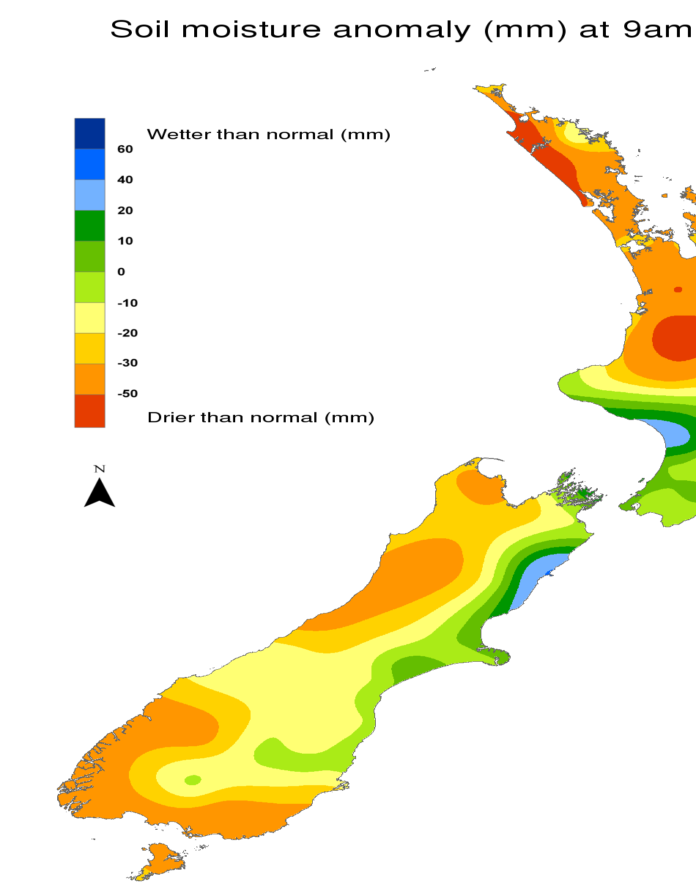Source: NIWA – National Institute of Water and Atmospheric Research
A weekly update describing soil moisture patterns across the country to show where dry to extremely dry conditions are occurring or imminent. Regions experiencing significant soil moisture deficits are deemed “hotspots”. Persistent hotspot regions have the potential to develop into drought.
Facts: Soil Moisture
In the North Island, meagre rainfall was observed in most areas during the past week, with most locations receiving less than 5 mm. A few localised areas received 10-20 mm, including eastern Northland, parts of Bay of Plenty, and northern Hawke’s Bay. This meagre rainfall resulted in moderate to large soil moisture decreases across the entire North Island. The driest soils across the North Island, when compared to normal for this time of the year, are found in western Northland and southern Waikato, while the wettest soils for this time of the year are found in coastal Manawatū-Whanganui.
Hotspots are now located across large portions of Northland, Auckland, and northern Waikato, along with northern Hawke’s Bay and a small portion of southern Hawke’s Bay. The New Zealand Drought Index (NZDI) map below shows that dry conditions are now located in much of Northland, northern Auckland, and northern Waikato as of 10 January.
In the South Island, many locations in northern and eastern areas saw light rainfall amounts of less than 10 mm. 15-30 mm was observed in parts of Otago, Southland, the lower West Coast, and small pockets of northern and central Canterbury. This resulted in moderate to large soil moisture decreases across nearly all of the South Island, although little change was observed in southern Otago and Southland. The driest soils in the South Island, when compared to normal for this time of the year, are located in Tasman, parts of the West Coast, and much of Southland, while the wettest soils for this time of the year are found in northern Canterbury.
Hotspots are currently located in Nelson and eastern Tasman, along with parts of southern Otago and coastal Southland. The New Zealand Drought Index (NZDI) map below shows that dry conditions are now located in southern Otago, eastern Southland, and Stewart Island. In addition, very dry conditions are located in parts of eastern Southland and Stewart Island as of 10 January.
Outlook and Soil Moisture
In the North Island, mostly dry weather is expected through at least Sunday morning (16 January) as high pressure controls the region’s weather. However, there is an increasing chance that ex-Tropical Cyclone Cody will impact the North Island on Sunday night and Monday, with areas of heavy rain likely. Currently, it appears that the heaviest rain would occur in the eastern half of the North Island. In these areas, widespread amounts of 50-75 mm will be possible, along with pockets of 100+ mm. In western and northern areas, amounts may be 30 mm or less. Beginning by late Tuesday (18 January), mostly dry weather is expected to return.
Due to the expected rainfall in the next week, soil moisture levels may increase substantially in the eastern North Island, while little change or even small soil moisture decreases could occur elsewhere. This would likely result in the current hotspots in Hawke’s Bay dissipating, while those in the upper North Island would likely remain in place.
In the South Island, high pressure will result in several days of almost completely dry weather, through at least midday on Monday (17 January). On Monday night and Tuesday, some rainfall associated with the remnants of Cody may impact Marlborough and northern Canterbury, although at this time amounts are not expected to be significant. On Wednesday (19 January) a front may move up the South Island, leading to light to moderate rainfall amounts. Weekly rainfall amounts of 10-20 mm could be widespread across the South Island, with some eastern areas perhaps reaching 20-30 mm.
Due to the expected weekly rainfall, small to moderate soil moisture decreases could occur about the western and southern South Island, with little change in the east. Current hotspots may strengthen and expand slightly.
Background:
Hotspot Watch: a weekly advisory service for New Zealand media. It provides soil moisture and precipitation measurements around the country to help assess whether extremely dry conditions are imminent.
Soil moisture deficit: the amount of water needed to bring the soil moisture content back to field capacity, which is the maximum amount of water the soil can hold.
Soil moisture anomaly: the difference between the historical normal soil moisture deficit (or surplus) for a given time of year and actual soil moisture deficits.
Definitions: “Extremely” and “severely” dry soils are based on a combination of the current soil moisture status and the difference from normal soil moisture (see soil moisture maps at https://www.niwa.co.nz/climate/nz-drought-monitor/droughtindicatormaps)
Hotspot: A hotspot is declared if soils are “severely drier than normal” which occurs when Soil Moisture Deficit (SMD) is less than -110 mm AND the Soil Moisture Anomaly is less than -20 mm.
Pictured above: Soil Moisture Anomaly Maps, relative to this time of year. The maps show soil moisture anomaly for the past two weeks.
New Zealand Drought Index (NZDI)
As of 10 January, the New Zealand Drought Index (NZDI) map below shows that dry conditions are now located in much of Northland, northern Auckland, northern Waikato, southern Otago, eastern Southland, and Stewart Island. In addition, very dry conditions are located in parts of eastern Southland and Stewart Island. Please note: some hotspots in the text above may not correspond with the NZDI map. This difference exists because the NZDI uses additional dryness indices, including one which integrates the rainfall deficit over the past 60 days. Changes are therefore slower to appear in the NZDI compared to soil moisture anomaly maps that are instantaneously updated.



